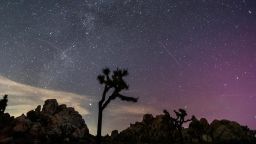Science
Sky Watchers Set for Spectacular Orionid Meteor Shower This Week

Sky-watchers around the globe are gearing up for a stunning celestial event as the Orionid meteor shower reaches its peak this week. Expected to peak on October 23, 2023, at 8 p.m. ET, the shower promises to deliver a display of bright meteors streaking across the night sky. According to EarthSky, this meteor shower is particularly notable for occasionally producing spectacular fireballs.
Robert Lunsford, fireball report coordinator for the American Meteor Society, noted that the Orionids do not have a sharp peak. He advised those hoping to catch the event not to be discouraged by cloudy weather on the peak night. “If you happen to get clouded out on that night, don’t despair,” he said. “Head on out the next night, next couple nights even, and you’ll see almost the same activity.”
This year’s meteor shower coincides with a new moon, which means the sky will be darker, allowing for better visibility of the meteors. Under optimal conditions, viewers can expect to see between 10 to 20 meteors per hour. The Orionids are known for their speed, with most meteors lasting only a fraction of a second. Lunsford added that the brighter meteors leave behind persistent trails, or smoke trails, that linger briefly after they have disappeared.
For those eager for more than just the Orionids, another meteor shower, the Southern Taurids, is also active and is expected to peak around November 4-5. This shower will coincide with a full moon, further enriching the celestial experience. While the Orionids originate from the constellation Orion, the Taurids come from Taurus, creating a fascinating dynamic in the night sky. “It’s kind of like they’re doing battle,” Lunsford remarked, as the slower Taurids move eastward toward Orion, while the fast-moving Orionids shoot westward toward Taurus.
To optimize viewing, Lunsford recommends looking towards the southern sky and being outside around 10 p.m. on October 23 or between 4 to 5 a.m. the following morning, adjusted to local time.
The Orionid meteor shower is a result of Earth passing through debris left behind by Halley’s Comet. According to NASA, Halley’s Comet crosses Earth’s orbit twice: once in October, resulting in the Orionids, and again in early May, when it causes the Eta Aquariids. Halley’s Comet was last visible from Earth in 1986 and has an orbital period of approximately 76 years, meaning it is expected to return in 2061.
As this week approaches, astronomy enthusiasts encourage everyone to step outside and witness the wonder of the universe. The Orionids offer not only a dazzling display but also a reminder of the ongoing celestial dance that connects Earth to the cosmos.
-

 Sports1 week ago
Sports1 week agoSteve Kerr Supports Jonathan Kuminga After Ejection in Preseason Game
-

 Politics1 week ago
Politics1 week agoDallin H. Oaks Assumes Leadership of Latter-day Saints Church
-

 Lifestyle1 week ago
Lifestyle1 week agoDua Lipa Celebrates Passing GCSE Spanish During World Tour
-

 Business1 week ago
Business1 week agoTyler Technologies Set to Reveal Q3 2025 Earnings on October 22
-

 Entertainment1 week ago
Entertainment1 week agoZoe Saldana Advocates for James Cameron’s Avatar Documentary
-

 Health1 week ago
Health1 week agoRichard Feldman Urges Ban on Menthol in Cigarettes and Vapes
-

 Health1 week ago
Health1 week agoCommunity Unites for Seventh Annual Mental Health Awareness Walk
-

 World1 week ago
World1 week agoD’Angelo, Iconic R&B Singer, Dies at 51 After Cancer Battle
-

 Science1 week ago
Science1 week agoChicago’s Viral ‘Rat Hole’ Likely Created by Squirrel, Study Reveals
-

 Lifestyle1 week ago
Lifestyle1 week agoKelsea Ballerini Launches ‘Burn the Baggage’ Candle with Ranger Station
-

 Business1 week ago
Business1 week agoMega Millions Jackpot Reaches $600 Million Ahead of Drawings
-

 Business1 week ago
Business1 week agoMLB Qualifying Offer Jumps to $22.02 Million for 2024









